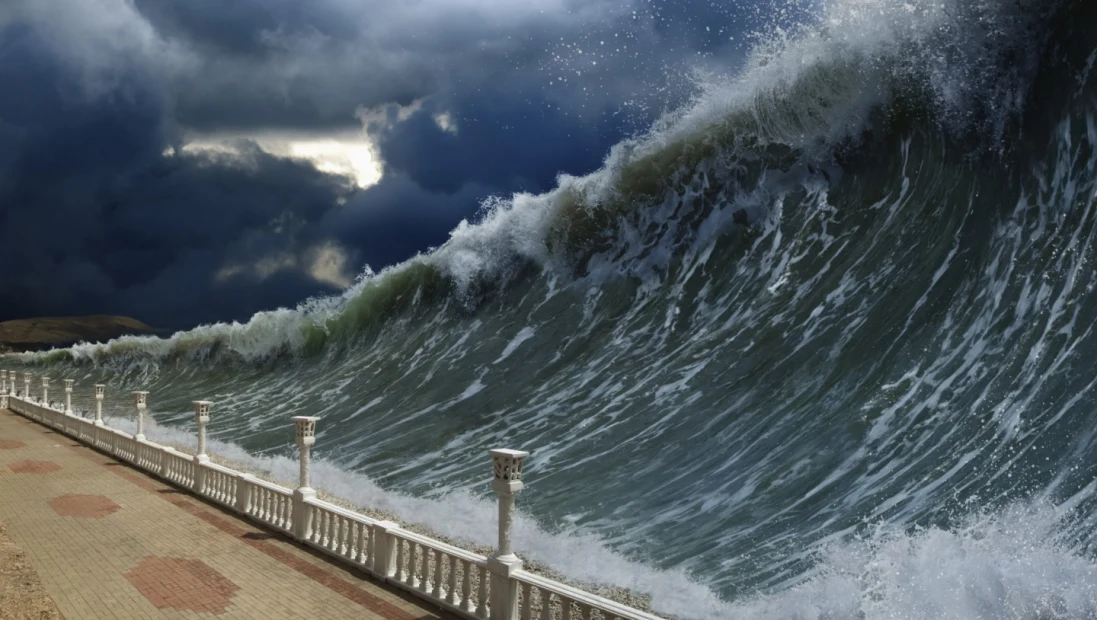Description

Disclaimer: Copyright infringement not intended.
Context
Tsunami is a Japanese word that means “harbour wave”. It is generally caused by earthquakes or volcanic eruptions under the ocean.
About Tsunami
- "Harbour waves" is what the word "tsunami" truly means. These are the waves in the sequence, and their lengthy wavelength is what sets them apart from one another.
- What is a Tsunami?
- Tsunamis are a sequence of extraordinarily long waves that are produced when the ocean shifts dramatically and suddenly as a result of earthquakes, volcanic eruptions, etc.
- These are among the most potent and destructive natural forces; they are also known as seismic sea waves.
- When they get to the coast, they can create strong currents that can linger for several hours or even days, as well as hazardous coastal flooding.
- Large earthquakes are the primary cause of most tsunamis. However, not every earthquake results in a tsunami.
Characteristics of Tsunami
- Tsunamis are among Earth’s most infrequent hazards and most of them are small and nondestructive.
- Over deep water, the tsunami has very long wavelengths (often hundreds of kilometres long) when a tsunami enters shallow water, its wavelength gets reduced and the period remains unchanged, which increases the wave height.
- Tsunamis have small amplitude (wave height) offshore.
- This can range from a few centimetres to over 30 m in height. However, most tsunamis have less than 3 m wave height.
- It radiates in all directions from the point of origin and covers the entire ocean.
- It generally consists of a series of waves, with periods ranging from minutes to hours.
- These are the waves generated by tremors and not by earthquakes themselves.
- There is no season for tsunamis and not all tsunamis act the same.
- It cannot be predicted where, when and how destructive it will be. A small tsunami in one place may be very large a few miles away.
- An individual tsunami may impact coasts differently.
- A tsunami can strike any ocean coast at any time.
- They pose a major threat to coastal communities.
- The effect of Tsunami would occur only if the epicentre of the tremor is below oceanic waters and the magnitude is sufficiently high.
- The speed of the wave in the ocean depends upon the depth of water.
- It is more in the shallow water than in the ocean deep. As a result of this, the impact of a tsunami is more near the coast and less over the ocean.

Causes of Tsunami
How are Tsunami generated?
- A Tsunami can be generated only through the vertical movement of the seafloor.
- Most Tsunamis are generated by earthquakes. Volcanic eruption, underwater explosion, landslides and meteorite impacts are some other causes of Tsunami.
- The details of causes of Tsunami is explained below-
- Earthquake – Tsunami is generated by the earthquake because of the disturbance of the seafloor and is formed generally with vertical displacement.
- Most Tsunami is generated by earthquakes that occur along the subduction boundaries of plates along the ocean trenches. The size of the Tsunami is related to the size of the earthquake.
- Underwater explosion – A Nuclear Testing by the US generated Tsunami in 1940 and 1950s in Marshall island.
- Volcanic eruption – Volcanoes that occur along the Coastal waters can cause several effects that can cause a tsunami.
- Landslides – Earthquake and volcanic eruptions generally generate landslides, these landslides when moving into the Oceans, bays and lakes can generate Tsunami.
- Meteorite Impacts – Though no historic example as such of meteorite impact has caused Tsunami, the apparent impact of a meteorite about 5 million years ago produced Tsunami leaving deposits along the Gulf Coast of Mexico and the United States.
|
PRACTICE QUESTION
Discuss the causes, characteristics, and mitigation strategies associated with tsunamis. How can governments and communities better prepare for and respond to tsunami threats? Provide specific examples from different regions prone to tsunamis.
|












